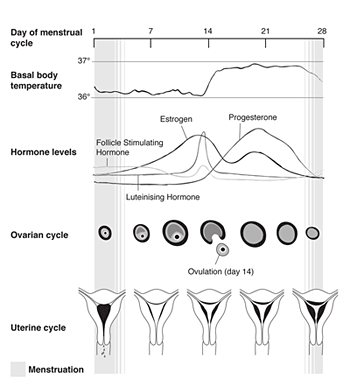Every month, the reproductive organs in a healthy woman prepare for pregnancy.
A complex interaction between the pituitary gland in the brain, the ovaries and the uterus work to create the perfect environment for ovulation (the release of an egg) to occur, for the sperm and egg to meet and for the fertilised egg to implant itself in the uterus.
A step-by-step guide to ovulation
- Every month the pituitary gland, which is in your brain, releases a hormone. This hormone tells the ovaries to produce a number of fluid-filled cysts called follicles. As the follicles grow they secrete the hormone oestrogen. Oestrogen works to thicken the wall of your uterus in preparation for pregnancy.
- On day seven of your cycle, the follicles stop growing except for one. This follicle continues to grow and to nourish a maturing egg (oocyte) within.
- On day 12 the maturing follicle releases a burst of oestrogen into the blood stream. The oestrogen travels through your blood. When the oestrogen reaches the pituitary gland in your brain, the pituitary gland responds by releasing the luteinising hormone. This hormone gives the follicle a sudden growth spurt.
- Right before ovulation, the egg inside the follicle detaches itself. The follicle starts to release chemicals that encourage the nearby fallopian tube to move closer and surround the follicle.
- The follicle swells until it bursts open, ejecting the egg and fluid into the abdominal cavity.
- Small finger like protrusions at the end of the fallopian tube, called fimbriae, sweep across the burst follicle and pick up the egg.
- The egg is transported to the entrance of the fallopian tube. Once inside the walls of the fallopian tube, muscle contractions push the egg gently towards the uterus.
- The egg will either meet sperm on its journey through the fallopian tube and fertilisation will happen, or it will arrive in the uterus unfertilised and be absorbed back into the body.

The menstrual cycle
A step-by-step guide to conception
After ovulation the egg lives for 12 to 24 hours and must be fertilised in that time if a woman is to become pregnant.
The burst of oestrogen just before ovulation also works inside the neck of the uterus (the cervix) to make protein-rich clear jelly that covers the top of the vagina during sex. This makes the vagina acidic (which prevents thrush and other infections). This is also a suitable environment for sperm survival. The sperm rapidly swim up and into the cervix, where they can survive in the mucus for up to five days before an egg is released.
When the egg is released at ovulation, it is covered in sticky cells, which help the fallopian tube to catch it. The egg and the sperm meet in the fallopian tube where the sperm start to digest the sticky cells. While it takes only one sperm to make a baby, several need to attach to the outer shell and the membrane of the egg before one can enter and fertilise it.
After fertilisation, the egg and sperm very quickly merge and divide to become an embryo and chemicals are released to stop other sperm from entering.
Over the next four or five days the fertilised egg continues to divide and to travel towards the uterus.
The hormone progesterone, which is secreted into your blood stream by the burst follicle (now called the corpus luteum) prepares the uterus for the egg to implant.
As the pregnancy grows and implants itself into the mother’s uterine lining and blood vessels, it is sending an increasingly strong signal to the ovary to prolong and increase its production of progesterone, which the pregnancy needs to survive.
Getting pregnant
The best time to attempt a pregnancy is in the three to six day leading up to and including ovulation. The most fertile days will vary depending on your cycle length.
If you are using contraception you will need to stop using it if you plan to get pregnant. There are no clear guidelines about when to stop using the Pill (oral contraception) if you are planning to get pregnant. Some health professionals suggest you have three normal menstrual periods, after stopping the Pill, to allow your metabolic function to return to normal. The length of time that it takes for fertility to return will differ for each woman. It is possible, although rare, for a woman to fall pregnant while on the Pill. There is no evidence that this causes problems for the baby.
Related information
- See also: Preparing for pregnancy for things to consider before you get pregnant
- Provide feedback about the content on this page
Disclaimer
The Women’s does not accept any liability to any person for the information or advice (or use of such information or advice) which is provided on the Website or incorporated into it by reference. The Women’s provide this information on the understanding that all persons accessing it take responsibility for assessing its relevance and accuracy. Women are encouraged to discuss their health needs with a health practitioner. If you have concerns about your health, you should seek advice from your health care provider or if you require urgent care you should go to the nearest Emergency Dept.